Daniel Arsham’s eroded relics are rooted in classical sculpture
The New York-based artist turns back time for an exhibition of crystallised busts, friezes and sculptures at Galerie Perrotin in Paris

For almost 15 years, American artist Daniel Arsham has recreated iconic cultural items from the 20th and 21st centuries, inviting audiences to see these commodities anew. Using his signature technique, he’s crystallised everything from Walkman cassette players and Sony headphones to Polaroid cameras, Smeg refrigerators and Nike classics.
Such artefacts are recast and reframed, often presented as partially eroded ‘future relics’ that reflect how our culture might be historicised by generations to come. For his current exhibition at Galerie Perrotin in Paris, however, Arsham has stepped back even further into history, leaving behind current and recent cultural movements in favour of those from the 7th century BC up until the early 1800s.
‘The idea to work with sculptures from classical antiquity came two years ago when I was in Paris preparing for a project with a museum,’ the New York-based artist explains. ‘I have always been interested in the way that objects move through time, but this is the first time I’m working with classical and ancient objects.’ To that end, the exhibition at Perrotin includes a series of large-scale busts, friezes and sculptures cast from the originals.

Installation view of ‘Paris, 3020’ at Perrotin. © The artist. Courtesy of Perrotin
We see Michelangelo’s Moses rendered in blue calcite and hydrostone, eroding near his thighs, chest and head. Alexandros of Antioch’s Venus de Milo, realised in white calcite, hews closely to the original – albeit with areas of her head, torso and right knee apparently weathering away. To create these works, Arsham was granted unprecedented access to the Réunion des Musées Nationaux – Grand Palais (RMN), a 200-year-old moulding studio that reproduces masterpieces for several major museums throughout Europe.
RELATED STORY
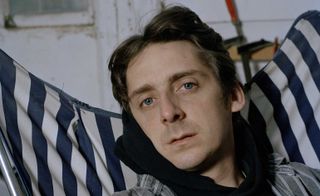
‘The RMN has a selection which includes thousands of moulds of works from antiquity to the Renaissance to neoclassical works,’ says the artist. Arsham sorted through these moulds and selected pieces to reform, a decision often based on two things: ‘one, the kind of historical context around some of these pieces and, two, around the works that were most visually iconic’. Finally, he ensured the pieces would work with his process, which involved recreating them in crystal, volcanic ash and ‘other materials that we associate with the geological time scale’.
The sculptures are presented on pristine plinths, illuminated from underneath by white fluorescent light. Sleek and cool, they are a stark reminder of where we’re standing: not in the Louvre or Acropolis Museum or the Kunsthistorisches Museum, but rather in a contemporary art gallery. The works here could easily be from the past, present or future, a confusion of time that is inherent to Arsham’s work. And just because the source material has changed doesn’t mean his artistic approach has become any different.
‘In general, I like try to create scenarios that allow these works to float in time,’ adds the artist. ‘I treated these [ancient] objects the same way that I would treat an Apple computer or a Jordan sneaker – objects that we associate with a particular era in history. And therefore, these objects can become useful in my project to confuse that history.’
Looking forward, we can expect to see more from the past. ‘I certainly will be engaging further with many of these objects,’ Arsham says. ‘There's a vast trove of moulds of these works that I now have access to, and the project is just beginning.’
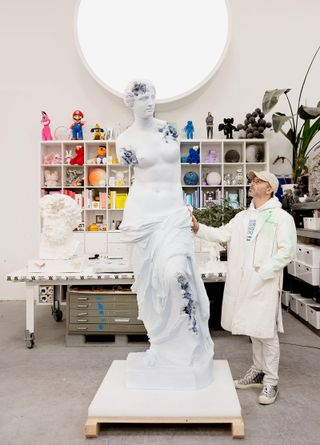
Daniel Arsham in his New York studio. © The artist. Courtesy of Perrotin
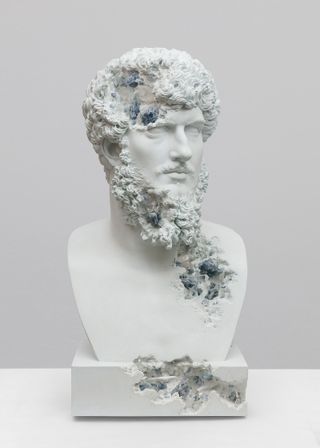
Blue Calcite Eroded Lucius Verus, 2019, by Daniel Arsham, blue calcite, hydrostone.
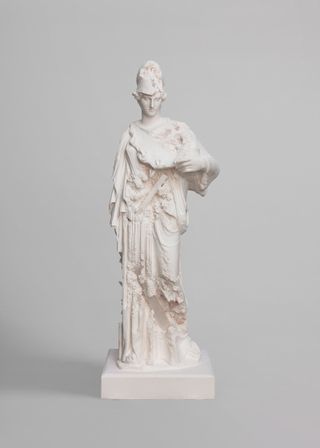
Rose Quartz Eroded Athena Helmeted, 2019, by Daniel Arsham, pink selenite, quartz, hydrostone.

Installation view of ‘Paris, 3020’ at Perrotin. © The artist. Courtesy of Perrotin
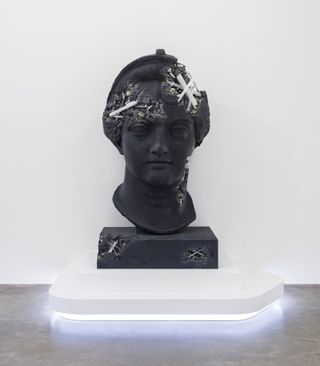
Installation view of ‘Paris, 3020’ at Perrotin. © The artist. Courtesy of Perrotin
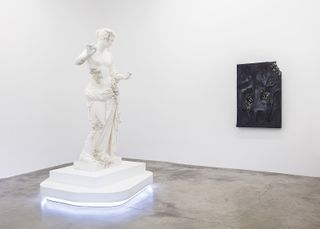
Installation view of ‘Paris, 3020’ at Perrotin. © The artist. Courtesy of Perrotin
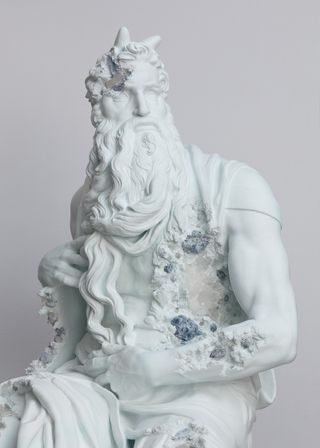
Blue Calcite Eroded Moses (detail) 2019, by Daniel Arsham, blue calcite, hydrostone. © The artist. Courtesy of Perrotin

Grey Selenite Eroded Aphrodite or Kore with a bird, 2019, by Daniel Arsham, selenite, quartz, hydrostone.

Installation view of ‘Paris, 3020’ at Perrotin. © The artist. Courtesy of Perrotin
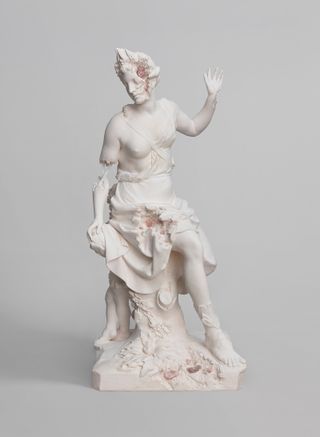
Rose Quartz Eroded Hamadryade, 2019, by Daniel Arsham, pink selenite, quartz, hydrostone. © The artist. Courtesy of Perrotin
INFORMATION
‘Paris, 3020’, 11 January – 21 March, Perrotin. perrotin.com; danielarsham.com
ADDRESS
Perrotin
76 rue de Turenne
75003 Paris
Wallpaper* Newsletter
Receive our daily digest of inspiration, escapism and design stories from around the world direct to your inbox
-
 Knoll presents Willo Perron sofa at Salone del Mobile 2024, 'a piece that can stay with you forever'
Knoll presents Willo Perron sofa at Salone del Mobile 2024, 'a piece that can stay with you forever'Salone del Mobile 2024: the ‘Pillo’ sofa by Willo Perron for Knoll is the California-based designer’s first piece for the American brand, prioritising comfort and timeless usability
By Rosa Bertoli Published
-
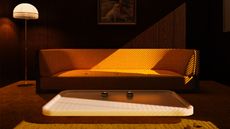 Nuova wants to 'bring time travel to the world' with their debut at Milan Design Week
Nuova wants to 'bring time travel to the world' with their debut at Milan Design WeekCalifornian design studio Nuova has been working behind closed doors for some of the biggest names in luxury and tech. The studio makes its public debut at Milan Design Week 2024, and take visitors on a journey back to 1971
By Laura May Todd Published
-
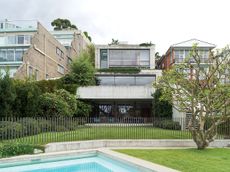 Lavender Bay house opens towards the water, overlooking Sydney harbour
Lavender Bay house opens towards the water, overlooking Sydney harbourLavender Bay house by Tobias Partners is an expansive family home overlooking Sydney harbour
By Ellie Stathaki Published
-
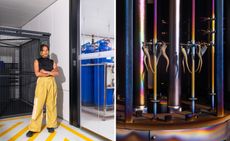 Josèfa Ntjam reveals mythical sculptures for her LVMH Métiers d’Art artist residency
Josèfa Ntjam reveals mythical sculptures for her LVMH Métiers d’Art artist residencyLVMH Métiers d’Art presents ‘Une cosmogonie d’océans’, celebrating Josèfa Ntjam’s artistic residence
By Tianna Williams Published
-
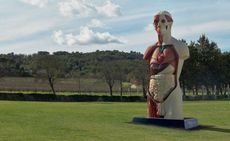 Damien Hirst takes over Château La Coste
Damien Hirst takes over Château La CosteDamien Hirst’s ‘The Light That Shines’ at Château La Coste includes new and existing work, and takes over the entire 500-acre estate in Provence
By Hannah Silver Published
-
 Peter Blake’s sculptures spark joy at Waddington Custot in London
Peter Blake’s sculptures spark joy at Waddington Custot in London‘Peter Blake: Sculpture and Other Matters’, at London's Waddington Custot, spans six decades of the artist's career
By Hannah Silver Published
-
 Oozing, squidgy, erupting forms come alive at Hayward Gallery
Oozing, squidgy, erupting forms come alive at Hayward Gallery‘When Forms Come Alive: Sixty Years of Restless Sculpture’ at Hayward Gallery, London, is a group show full of twists and turns
By Hannah Silver Published
-
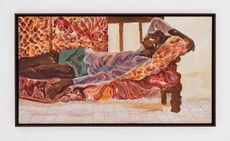 Ludovic Nkoth’s vibrant paintings reflect on migration
Ludovic Nkoth’s vibrant paintings reflect on migrationCameroon-born, New York-based Ludovic Nkoth uses acrylic paint to strike a balance between abstraction and figuration
By Ugonna-Ora Owoh Published
-
 Heads up: art exhibitions to see in January 2024
Heads up: art exhibitions to see in January 2024Start the year right with the Wallpaper* pick of art exhibitions to see in January 2024
By Hannah Silver Published
-
 Tia-Thuy Nguyen encases Chateau La Coste oak tree in tonne of stainless steel strips
Tia-Thuy Nguyen encases Chateau La Coste oak tree in tonne of stainless steel stripsTia-Thuy Nguyen’s ‘Flower of Life’ lives in the grounds of sculpture park and organic winery Château La Coste in France
By Harriet Quick Published
-
 Paris Photo 2023: Eva Nielsen puts our impact on the Camargue in dynamic focus
Paris Photo 2023: Eva Nielsen puts our impact on the Camargue in dynamic focusAt Paris Photo 2023, ‘Insolare’ by Eva Nielsen, in collaboration with BMW Art Makers, is a compelling exploration of human impact on the landscape
By Sophie Gladstone Published